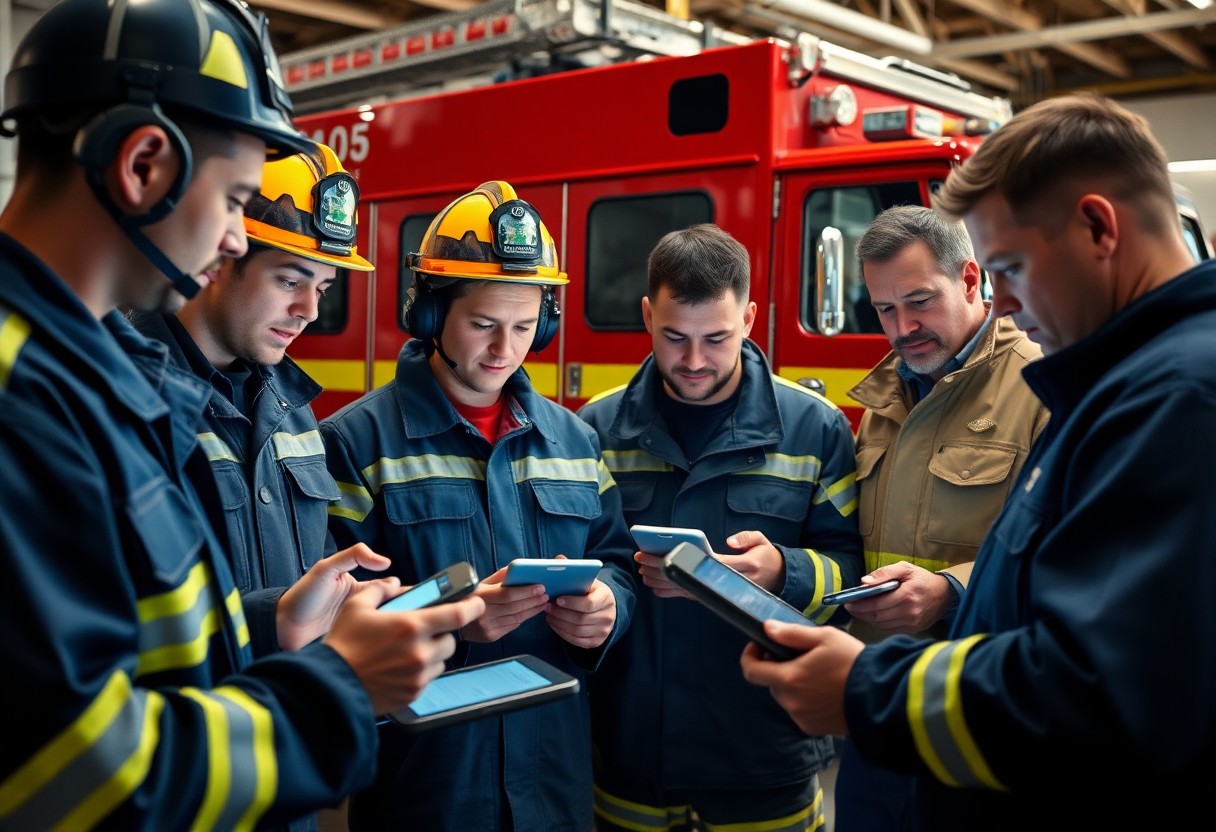There’s a growing need for effective communication within volunteer fire departments as they strive to respond quickly and efficiently. By leveraging technology, you can enhance coordination among team members, streamline operations, and ensure timely information sharing. From utilizing dedicated communication apps to implementing real-time data sharing tools, you have various options at your disposal. This guide will provide you with practical strategies to optimize your department’s communication and improve overall performance, ultimately leading to better service for your community.
Understanding Communication Needs in Volunteer Fire Departments
To effectively enhance communications within your volunteer fire department, it’s crucial to understand your unique communication needs. Assessing your current processes and recognizing the challenges faced by team members while on and off the field can help you identify areas in need of improvement. Engaging with your volunteers provides valuable insights into how they prefer to receive and exchange information—this understanding will ultimately lead to better coordination and response times in emergencies.
Assessing Current Communication Methods
Any effective communication strategy begins with a thorough assessment of your current communication methods. Take the time to evaluate how your team communicates, both during training sessions and real-life scenarios. Determine whether you primarily use radios, phone calls, texts, or other applications, and identify any shortcomings in these methods. You may find that enhancing one or more aspects of your communication can significantly improve overall cohesion and response timing.
Identifying Key Stakeholders
Methods for identifying key stakeholders in your volunteer fire department involve recognizing the individuals and groups vital to effective communication. This includes your volunteers, team leaders, local government representatives, and community members. Understanding who needs to be involved in communication planning ensures that all crucial voices are heard and that your strategies address the interests and concerns of everyone involved.
Volunteer fire departments are typically made up of diverse members, each with unique perspectives and roles that influence communication dynamics. Consider reaching out to firefighters, administrative personnel, and support staff, as well as community leaders and local officials. Their input can help you build a comprehensive communication framework that fosters collaboration and efficient information sharing. By engaging all key stakeholders, you position your department to tackle challenges together and streamline operations effectively.
How to Select the Right Technology Tools
The selection of the right technology tools for your volunteer fire department is crucial for enhancing communication and operational efficiency. Begin by assessing your department’s specific needs, resources, and any existing technology. Consider factors such as ease of use, integration capabilities, and scalability. The right tools should improve communication among team members, streamline workflows, and ultimately support your mission effectively.
Evaluating Software Solutions
Some software solutions may seem appealing at first glance, but it’s critical to evaluate their functionalities against your department’s requirements. Look for tools that offer features tailored to emergency services, such as incident reporting, scheduling, and team messaging. Avoid overly complex systems that could lead to user frustration.
Choosing Communication Hardware
Hardware choices play a significant role in ensuring smooth communication during emergency responses. Your department should consider the durability, reliability, and compatibility of devices like radios, smartphones, or tablets. Selecting equipment that functions effectively in high-pressure situations can greatly enhance your team’s coordination and response times.
For instance, opting for ruggedized two-way radios designed for emergency responders can provide reliable communication in varying conditions. Ensure that your hardware has a strong battery life and can operate in areas with poor signal. Investing in quality headsets or earpieces can also enhance audio clarity, allowing your team to communicate effectively even in noisy environments. Choosing the right hardware ultimately leads to greater operational efficiency and safety.
Tips for Implementing New Communication Technologies
Even the best technology can fall flat without proper implementation. To ensure a smooth transition, consider these tips:
- Assess your department’s specific communication needs.
- Involve volunteers in the selection process for new tools.
- Define clear guidelines for usage across the team.
- Regularly solicit feedback on the effectiveness of new systems.
- Be patient; allow time for adaptation to new technologies.
Any successful implementation hinges on proper planning and collaboration among your team.
Training Volunteers on New Tools
Some volunteers may feel overwhelmed by new technology; thus, training is vital. Develop training sessions tailored to different skill levels and ensure everyone has access to hands-on practice. Make materials available online for those needing refresher courses, and encourage team leaders to foster a supportive learning atmosphere.
Establishing Standard Operating Procedures
Clearly defined Standard Operating Procedures (SOPs) enhance clarity and consistency in your communications. By establishing these guidelines, you create a framework that every volunteer can follow, minimizing confusion and errors in urgent situations. SOPs also help streamline the use of new tools while addressing varying levels of tech proficiency among volunteers.
Tips for establishing effective SOPs include involving your team in the development process and regularly updating the procedures to keep pace with technological advancements and departmental changes. Create simple, accessible documents that outline the purpose and procedures associated with each communication tool. By ensuring everyone understands and agrees upon the SOPs, you facilitate smoother operations and improve overall communication flow.
Factors Influencing Successful Communication
Keep in mind that several factors can significantly impact communication effectiveness within your volunteer fire department. Prioritizing these elements can enhance your team’s ability to collaborate and respond efficiently:
- Organizational culture and leadership support
- Technological reliability and user-friendliness
- Consistency in communication practices
- Training and skill levels of personnel
This collective focus fosters an environment where communication thrives.
Organizational Culture and Buy-In
For successful communication, your organizational culture must support openness and collaboration. When team members believe in the importance of effective communication, they are more likely to participate actively. Building trust and reinforcing the value of technology enables buy-in, which is vital for integrating new tools into your department’s daily operations.
Reliability and Accessibility of Technology
Communication tools must be reliable and easily accessible for your team to communicate effectively. If technology fails or is difficult to use, it hinders collaboration and responsiveness.
Understanding the importance of reliable technology means prioritizing tools that meet your fire department’s needs while being user-friendly. When you choose systems with minimal downtime and ensure accessibility for all team members, you facilitate smoother operations and quicker responses during emergencies. It’s also imperative to regularly evaluate and update your tools to keep pace with changing requirements and advancements in communication technology.
Enhancing Community Engagement Through Technology
Unlike traditional methods, technology provides you with innovative ways to engage your community effectively. By leveraging digital tools, you can create meaningful connections and foster a sense of belonging among community members. These modern approaches not only keep your volunteers informed but also invite greater participation from the public, ensuring that your fire department remains a vital part of community life.
Utilizing Social Media and Outreach Platforms
On social media platforms, you can share updates, safety tips, and event announcements to reach a broader audience. Engaging content, such as videos and photos of your activities, helps humanize your department and invites community interaction. By consistently posting relevant information, you enhance visibility and create an open channel for dialogue with residents.
Building a Transparent Communication Strategy
While transparency is key to fostering trust within your community, an effective communication strategy helps you convey consistent and accurate information. It’s crucial to keep the lines of communication open, allowing you to share both successes and challenges. This proactive engagement demonstrates your accountability and commitment to serving your community.
Technology enables you to implement a transparent communication strategy by providing various platforms for sharing information and updates. You can utilize email newsletters, community bulletins, and dedicated websites to keep your audience informed about department operations and initiatives. By encouraging feedback and addressing community concerns promptly, you reinforce trust and collaboration, ultimately enhancing your relationship with the community you serve.
Monitoring and Evaluating Communication Effectiveness
Now that you’ve implemented technology for communication in your volunteer fire department, it’s imperative to monitor and evaluate its effectiveness. Regular assessment allows you to identify strengths and weaknesses in your communication strategy. By analyzing the data collected, you can make informed decisions that enhance team collaboration and improve overall efficiency during emergency situations.
Gathering Feedback from Team Members
There’s no better way to assess your communication systems than by directly gathering feedback from your team members. Encourage an open dialogue where they can share their experiences and insights on communication tools. This input can help you identify areas needing improvement and adapt your strategies to better meet your team’s needs.
Using Metrics to Measure Success
You can evaluate the effectiveness of your communication strategies by using various metrics to measure success. Tracking response times, engagement rates with communication tools, and the frequency of misunderstandings can provide valuable insights into how well your systems are functioning.
This data allows you to set benchmarks and goals for improvement, enabling you to fine-tune your communication methods. By regularly reviewing these metrics, you can pinpoint trends and make data-driven decisions that enhance your volunteer fire department’s communication landscape, ensuring that your team is always prepared to respond effectively.
To wrap up
As a reminder, leveraging technology in your volunteer fire department can significantly enhance communication efficiency and effectiveness. By utilizing tools such as mobile apps, group messaging platforms, and incident management software, you can ensure that your team is always connected and well-informed. Embrace digital training sessions to keep everyone updated on protocols and equipment. With these strategies, you not only improve coordination but also foster a stronger sense of community among your members, allowing you to respond swiftly and effectively when duty calls.

